
CZECH UNDERGROUNDFriday 20 January 2018 8.30 pm
Independent films from the 1970`s and 80`s
After the drama of occupation by Warsaw Pact troops in the CSSR in the year 1968 a period of social paralysis began, paradoxically called 'normalisation'. In the 1970's and 80's an artistic underground developed in the CSSR. In the course of this there were definite parallels to developments in the GDR, even if the artistic scenes in both countries had little contact with one another. Dating from this time are films by Jan Ságl, about the milieau surrounding the legendary czech band 'The Plastic People of the Universe' and we'll be showing films from the 1980's as well from the artists Caroděj Oz, Pablo de Sax, Pigi and Pan Karra, all working under pseudonyms, as well as from Ivan Tatíček . The czech media historian Tomáš Glanc who teaches in Zurich and Basel, and who for many years has investigated the parallel artistic cultures in the russian and the czech art scene, gives us an introduction to the historical context of the time.
Moderation: Martin Blažíček, Frank Eckhardt
The Films:
Jan Ságl – Music F Club
1971, Super-8, 7.5 min, b/w, no sound
A concert by the Plastic People and Aktual at the Music F Club on 26 February 1971 – usually called one of the key events of the Czech underground. The film captures pre-concert preparations and the concert itself, including the industrial elements of Milan Knížák’s Aktual (the use of power drill, metal percussion, various objects, and throwing rice into the audience). The second part of the film shows some of the costumes and stage designs that Jan Ságl made for the Plastics’ concerts with his wife Zorka Ságlová. Cast: Milan Hlavsa, Jiří Kabeš, Paul Wilson, Pavel Zeman, Karel Nepraš, Pavel Tichý, Milan Knížák, Ivan Čori.
Karra – Silence
1981, Super-8, 2.5 min, b/w
Karra's films represent the most satirical position of the Czech underground film. In a number of cases, parts of world cinematography are being inscribed, transforming them into simple sketches, such as this paraphrase on Bergman's Silence. In addition, a wonderful parable of the situation in the 1980s.
Čaroděj OZ – Precedens: What is Left to Do?
1986, Super-8, 8 min, col.
The film captures the conflict between the inner world of a man and the society publicly celebrating the military. The film is composed of authentic recordings of military parades and oaths in 1980s. These two themes are expressed as literal allegories in which, for example, a wheelchair is likened to a tank or figures of angels are connected with missile warheads, the metal structures of children’s climbing frames symbolise both play and a prison.
Čaroděj OZ – Z jedné strany na druhou: Sieh des Todes Blasses Bild
1985, Super-8, 6.5 min, col.
Mácha’s poem Sieh des Todes Blasses Bild accompanied with music by the band Z jedné strany na druhou, composed, among others, of the former members of the Plastic People of the Universe: Ladislav Leština, Jan Brabec, Andrea Landovská and Vít Brukner. Its grotesque stylisation using black raincoats and melancholic rain evokes a romantic vision of the myth of Prometheus. Cast: Ladislav Leština, Jan Brabec, Vít Brukner, Andrea Landovská; music: Z jedné strany na druhou (song Sieh des Todes Blasses Bild using a poem by K. H. Mácha).
Pablo De Sax – For All of Eternity
1986, Super-8, 12 min, col.
Dystopia and the end of civilization are frequent themes among the underground movies. The film For All of Eternity is directly inspired by Reggio's Koyaanisqatsi and it tranforms the format of the city's symphony into the apocalyptic industrial areas around Prague. The very name of the film is the second part of the symptomatic 80s propaganda slogan „With the Soviet Union for all of eternity“.
Pablo De Sax – Plastic People: Teenage Girls
1985, Super-8, 8 min, b/w
The Plastic People music video as seen by the second generation of the underground. Inspired by the original lyrics, it shifts the song into satirical sketch.
Pigi – Dolce far niente
1983, Super-8, 1.5 min, b/w, no sound, VHS screener
An impromptu captured film study on laziness.
Pigi – Viva l’anarchy
1983, Super-8, 5 min 16 sec, b/w, no sound
The film about a trip to capital city is in a genre grotesque and it presents a typical protagonist of underground films - an individual acting out of society. It also captures a frequent strategy of filming action events in authentic social situation.
Pigi – A Bathroom Mystery
1985, Super-8, 5 min, b/w
Improvised dancing etude, in which an unrestrained bathroom creature takes the regular personal hygiene routine ad absurdum. The film was made in a bathroom in a block of flats in the Petřiny housing estate on one rainy afternoon.
Ivan Tatíček – Metrofilm
1984, Super-8, 8.5 min, b/w, VHS screener
The 1980's filmwork of Ivan Tatíček was closely connected with the band Schodiště, whose music also dominates Metrofilm. The film captures the melancholic mood of the mid-1980s that blends elements of late communism with the effects of post-punk and new wave.
- 18.01.Thursday
- 19.01.Friday
- 20.01.Saturday
- 21.01.Sunday - Thalia Sceening
- 00.00.Overview
----------------------------stills----------------------------
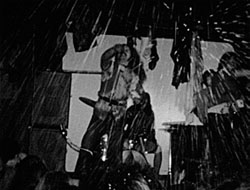
Jan Ságl: Music F Club.

Pan Karra: Silence, 1981.
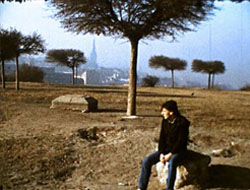
Čaroděj OZ: Precedens: What is Left to Do? .
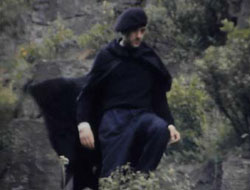
Čaroděj OZ: Sieh des Todes Blasses Bild.
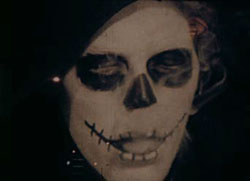
Pablo de Sax: For All of Eternity.

Pablo de Sax:Teenage Girls.
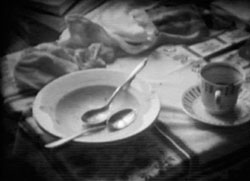
Pigi: Dolce far niente.
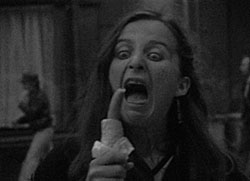
Pigi: Viva l’anarchy.
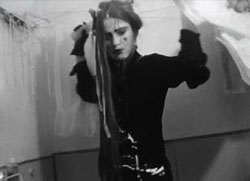
Pigi: A Bathroom Mystery.
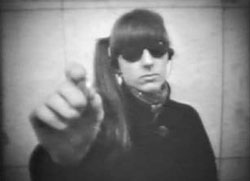
Ivan Tatíček: Metrofilm.

